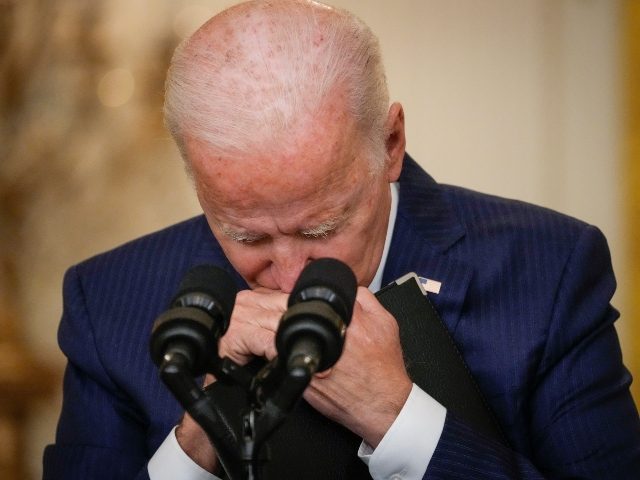U.S. consumer prices jumped by the most in nearly four decades as the new year started, sapping the savings of American families, diminishing the purchasing power of worker paychecks, and putting pressure on the Federal Reserve to hike interest rates beginning in March.
The consumer price index climbed 0.6 percent from a month before, the Department of Labor said Thursday. Compared with January of last year, consumer prices are up 7.5 percent.
Economists had expected prices to rise 0.4 percent on a monthly basis and 7.2 percent above a year ago’s prices.


In December, consumer prices rose 0.6 percent compared with November. For the full year, prices were up seven percent in 2021, the worst annual inflation since 1982.
Excluding the volatile food and energy components, so-called core prices rose by 0.6 percent. The measure soared six percent from a year earlier. Both exceeded economist estimates.

Although many economists and anti-Trump journalists claimed President Donald Trump’s tariffs would raise prices, consumer prices remained low throughout his administration. Trump’s tariffs turned out not to be taxes on consumers. Instead, they were absorbed by Chinese producers and exporters and the profit margins of most large U.S. companies.
Inflation only began to accelerate last March after years of coming in below the Fed’s two percent target. The Fed had decided to keep interest rates low although the economy was recovering at a faster than expected rate. What’s more, the Biden administration pushed through billions of dollars of deficit spending in the American Rescue Plan. These combined to fuel demand for goods and services faster than supplies could expand, pushing up prices.
Federal Reserve chief Jerome Powell, following the advice of many of the economists on the central bank’s staff, initially claimed that inflation was due to transitory factors. Fed officials forecast that inflation would fall in the latter half of 2021, predicting that supply chains would swiftly unsnarl and a rebalancing of consumer demand from goods to services would relieve pricing pressure. The Biden administration, under the tutelage of former Fed chair and now Treasury Secretary Janet Yellen, largely followed suit and continued to press for even more spending.
Establishment media largely parrotted these views, portraying the surge in inflation as a temporary shift higher due to the reopening of the economy. Many establishment outlets described fears of longer-lasting inflation as the product of partisan fear-monger and claimed they had no rational basis. Some of the same outlets that had claimed, without evidence, that Trump’s tariffs were raising prices now insisted price increases under Biden were no big deal. Some said that a silver lining of inflation would be higher wages. In fact, prices have been rising faster than wages, lowering the standard of living for many American families, and the hardest hit have been lower-income Americans.
That unanimity in government and establishment media proved calamitous. Inflation continued to soar, sapping the credibility of the Biden administration and the central bank when it came to inflation. Late last year, Fed officials dropped the word “transitory” from their vocabulary and began signaling that they would raise interest rates this year. Resistance from centrist Democrat Joe Manchin (D-WV) to spending more while the economy was suffering from decades-high inflation killed the Biden administration’s push for a so-called “human infrastructure” spending bill that its advocates had touted as the signature legislation of President Joe Biden and the greatest expansion of government since FDR’s New Deal and LBJ’s Great Society.
The public’s perception of President Biden’s competence has collapsed. Many Americans interpreted the administration’s confidence that inflation would pass to be a sign that it did not care about the hardships inflicted upon families paying more for gasoline, groceries, and Christmas gifts. Attempts by the administration to blame corporate greed for high prices fell flat. Although the Biden administration announced the biggest ever release of oil from the government’s emergency reserve–a norm-defying dip into an asset normally held tightly and used only for events like natural disasters or wars–oil and gasoline prices have continued to rise to the highest level in years.
Polls show the public’s rating of Biden’s handling of the economy is at a record low. Biden’s overall approval rating has plummeted. Forty-five percent of Americans say inflation has put a strain on household finances.
The Federal Reserve is expected to raise its target interest rate in March, months earlier than market watchers thought last year. Swaps prices prior to the release of consumer prices on Thursday implied about a twenty-five percent chance that the Fed will raise its target by two notches, a half a percentage point, at the March meeting, breaking the recent pattern of raising the target by just one-quarter of a percentage point at each meeting. After the release, the odds of a half-point hike jumped to 44 percent. Fed watchers are also debating how many times the Fed will hike rates, with swaps prices now implying at least three and perhaps four hikes this year. Many analysts, however, increasingly think the Fed will hike five to seven times this year as inflation proves less tractable than officials believed.

COMMENTS
Please let us know if you're having issues with commenting.